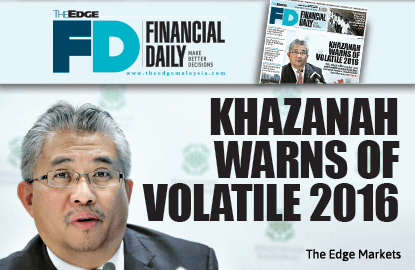
This article first appeared in The Edge Financial Daily, on January 14, 2016.

KUALA LUMPUR: Khazanah Nasional Bhd, the country’s sovereign wealth fund, is bracing for another volatile year following disappointing data in 2015, which saw its net worth adjusted (NWA) of its investment portfolio — a measure of value created — fall 1.6% to RM109 billion from RM110.7 billion the previous year.
Describing 2015 as a “roller coaster” year, Khazanah managing director Tan Sri Azman Mokhtar said the falling value of the ringgit, which was among the world’s worst-performing currencies last year, was partly to be blamed for the lower NWA.
The fund’s realisable asset value (RAV), however, rose 3.2% to RM150.2 billion last year from RM145.5 billion in 2014. Malaysia accounted for 55.1% of Khazanah’s RAV by geographic exposure; while sector-wise, media and communications stood at 22%, followed by healthcare (17.2%), power (15.3%), financial institution groups (13.7%) and property (10.6%).
“Our [2015 NWA] performance might be slightly worse than the FBM KLCI [which dropped by 1% last year], but we fared better than most of the reference regional markets,” Azman told reporters at the 12th Khazanah Annual Review yesterday.
In its presentation, Khazanah compared its investment portfolio against the FBM KLCI, the Straits Times Index (-11.4%), the Jakarta Composite Index (-10.5%), the Hang Seng Index (-4%), Sensex (-3.7%), the Philippines Index (-2%), the Istanbul Index (-14.1%), the MSCI Emerging Markets (-14.9%), the MSCI Asia ex-Japan (-9.2%) and the MSCI AC World (-0.3%).
The sole index seeing growth in Khazanah’s reference regional index was the Shanghai Index, which rose by 11.2% in 2015.
“The weak ringgit did have some effect on our foreign liabilities. Yes, we have US dollar-denominated assets like our shares in Alibaba Group Holding Ltd, which would have strengthened the asset value. On a net-net basis, the weak ringgit did have some effect on our investments, although not by much,” Azman said.
Towards this end, he said Khazanah has capped its foreign liabilities to 30% of its investment portfolio, “when at one point, it was more than 50%”.
Looking at its major investments, only the healthcare sector, particularly IHH Healthcare Bhd, made a positive contribution to its NWA with a RM6.5 billion increase in 2015.
Other sectors saw declines. Khazanah’s investments in CIMB Group Holdings Bhd saw the biggest decline of RM2.3 billion, and its stake in the telecommunications sector, specifically Telekom Malaysia Bhd and Axiata Group Bhd, declined RM900 million in net worth. Its foreign holdings in Alibaba, meanwhile, also declined by RM100 million.
Khazanah’s RAV cover — the ratio of its RAV to liabilities — came to 3.1 times in 2015, down from the previous year’s 3.7 times.
Khazanah’s profit before tax also fell by 63.4% for the financial year ended Dec 31, 2015 (FY15) to RM1.18 billion, from RM3.22 billion in FY14. This is the first time since the global financial crisis that Khazanah’s annual profit fell, excluding FY12 because of PLUS Expressways Bhd’s privatisation that occurred in FY11.
Despite weaker profitability, Khazanah increased its dividend payout to the government by 16.7% to RM1.05 billion in FY15, from RM900 million the previous year.
“We might not be a listed company, but we want to have a dividend payout that is in line with major listed companies, where ideally you increase the payout gradually. And when there are years that you get a windfall, you declare special dividends,” said Azman.
“It’s not good to have a yo-yo pattern of dividends. The payout should have a steady progression.”
Azman said while Khazanah expects this year will be another bumpy one, the higher dividend payout and lack of profit growth last year would not affect its funds, should it decide to make new investments this year.
“By other metrics, like our asset cover ratio, cash flow, liquidity, we have enough to take advantage of the market this year when there are opportunities,” he said.
But this doesn’t mean that Khazanah wouldn’t be careful with its investments this year, Azman said.
“In times of turbulence, we need to look at the quality of our balance sheet and our RAV cover, a critical ratio that we have always looked at, [which] indicates that we are coming from a position of relative strength.

“The issue is more on the fact that in volatile and uncertain times, there is the risk of being too early or too late [in making investments], and trying to time the entry is not easy,” he added.
Looking at the first week of trading in 2016, where the world markets fell when Chinese stock markets were shut down twice after plummeting by 7%, he expects to see volatility continuing this year.
“We don’t get funds coming in every month. It’s not like a pension fund where there are new deposits coming in. We have to be careful with our investments,” Azman said.
In 2015, Khazanah made 23 investments totalling RM8.7 billion and 10 divestments worth RM5.3 billion, with gains of RM2.9 billion. To date, the fund has made a total of 144 investments worth RM74.7 billion, as well as 77 divestments with overall gains of RM22.3 billion.
Meanwhile, Azman said Khazanah had injected RM1 billion into ValueCap Sdn Bhd, following Prime Minister Datuk Seri Najib Razak’s directive last year to the equity investment firm to help prop up the stock market. Khazanah is one of the three shareholders of ValueCap, besides Kumpulan Wang Persaraan (Diperbadankan) and Permodalan Nasional Bhd.